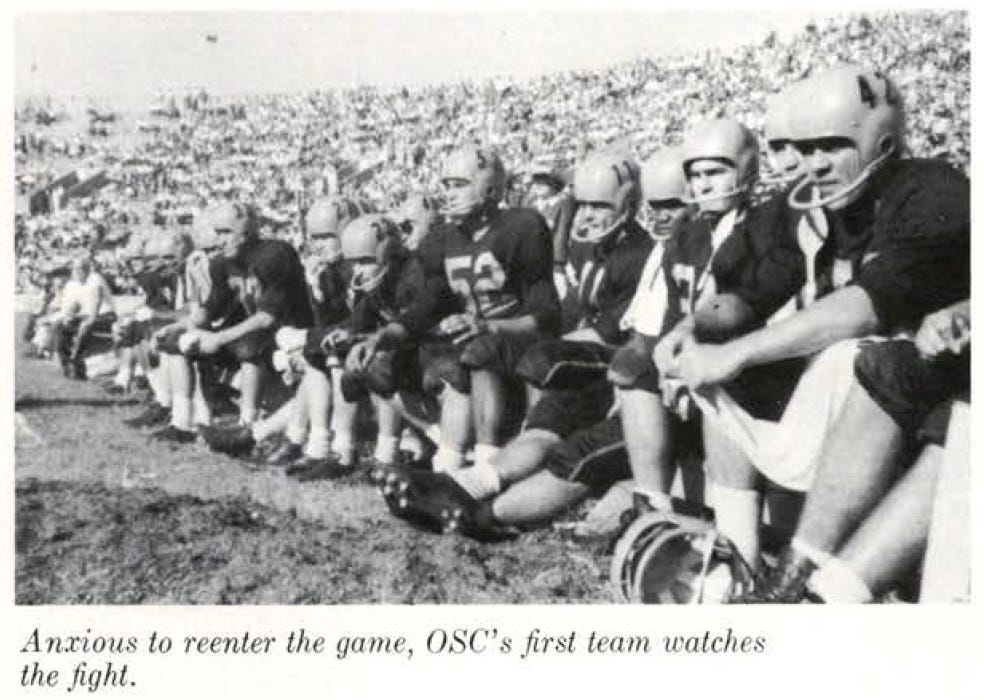Wild Card Substitutions and the Small College Rebellion
College football adopted free substitution in 1941 due to concerns about roster sizes as the U.S. geared up for World War II. Despite the rule change, two-platoon football did not arrive until 1945, when Michigan implemented the practice against Army. Platooning gained popularity in the late 1940s, but college football's rule-makers rejected the two-platoon system in 1953 when they reimposed restrictions on player substitution.

The limited substitution rule had philosophical and financial justifications. The philosophical side argued that players should participate on both offense and defense to develop well-rounded players rather than specialists.
On the financial side, the early 1950s saw numerous schools drop football, in part because the two-platoon system required larger rosters, higher equipment and travel costs, and more coaches. The NCAA justified the rule change as benefiting small colleges since they could least afford the expenses of two-platoon football. That justification was both true and false, depending on how you defined small colleges.
The NCAA did not have Division I, II, and III tiers at the time, so "small college" encompassed the schools that now inhabit Division III, as well as those that fall into FCS and even G5. The latter group was focused on the financial implications of two-platoon football, as they tried to compete with the big boys despite having thinner wallets.
The Division III-type schools and those in the NAIA did not have those ambitions. They viewed football as a recruiting tool for their schools and as a means of broadening students' experiences. With their smaller rosters, their coaches wanted the flexibility to insert specialists while also allowing a higher percentage of their rosters to participate in games.
So, when the NCAA passed rules limiting substitutions, the NAIA schools stopped using the NCAA rulebook, and hundreds of NCAA small colleges rejected the substitution rules as well. Later in the decade, hundreds of small schools also rejected the NCAA's widening of the goal posts and the addition of the two-point conversion, at least for the time being.
While the small school rebellion sheds an interesting light on 1950s football, we also need to discuss some of the crazy substitution rules implemented during this period. While Football Archaeology previously covered many of these rules, the "wild card" rule of 1958 has not been covered.
In the mid-1950s, players who left the game could not return until a subsequent quarter or the last four minutes of the second and fourth quarters. Illegally substituting a player resulted in a 25-yard penalty, so teams instituted record-keeping practices and even separate benches to distinguish who could and could not enter the game at a given time. Teams also gave their first unit of two-way players a rest by substituting a full second team in the closing minutes of a quarter.
During some years, only the players starting the quarter could return to the game during that quarter. However, as coaches pushed for more liberalized substitutions, the NCAA expanded substitution rules by allowing each player to enter the game twice per quarter. Players had to check in with the game officials, who tracked each player's entry and exit, resulting in extended delays for the officials to handle the record-keeping.
The wild card rule arrived in 1959. It allowed one player to enter the game whenever the clock stopped, such as for an extra point attempt, following the ball going out of bounds, or after an incomplete pass, without counting as one of the players' two opportunities per quarter. The combination of the wild card rule and the wider goal post helped rejuvenate field goal kicking in college football, so it had that going for it, but not much else.
It's a complex system to explain now, and it was a more difficult system to follow at the time, which led to its elimination. In 1964, the rule makers scrapped the system to allow free substitution whenever the clock stopped, while up to two players could enter the game on each down while the clock was running. College football had not achieved free substitution, but that day arrived one year later when any number of players could enter the game each down, whether the clock was running or not, with no limit on the number of times an individual player entered or exited.
Free substitution enabled increased specialization, allowed coaches to call offensive and defensive plays, and switch player packages on each down. Now, a two-way player like Travis Hunter, whose playing time was the norm in the 1950s, is viewed as an aberration.
Thanks to Russell Roberts for suggesting this topic.
Click Support Football Archaeology for options to support this site beyond a free subscription.




